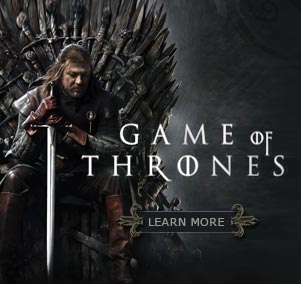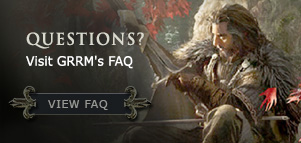
          |
FAQQ: I would like to request a signature or send a letter to GRRM, what are your Fan Mail procedures? A: We don’t accept books for signature in the mail, we will not return your book if you send it for signature. If you would like a signed bookplate you can request one from the same address where you can send fan letters listed below. Please include a self addressed envelope with postage for a prompt return. We save all fan art and letters in our archive files located at Texas A&M. 103 Salvador Place, Santa Fe NM 87501 Q: I want to be a writer. Can you give me any advice? A: The most important thing for any aspiring writer, I think, is to read! And not just the sort of thing you’re trying to write, be that fantasy, SF, comic books, whatever. You need to read everything. Read fiction, non-fiction, magazines, newspapers. Read history, historical fiction, biography. Read mystery novels, fantasy, SF, horror, mainstream, literary classics, erotica, adventure, satire. Every writer has something to teach you, for good or ill. (And yes, you can learn from bad books as well as good ones — what not to do) And write. Write every day, even if it is only a page or two. The more you write, the better you’ll get. But don’t write in my universe, or Tolkien’s, or the Marvel universe, or the Star Trek universe, or any other borrowed background. Every writer needs to learn to create his own characters, worlds, and settings. Using someone else’s world is the lazy way out. If you don’t exercise those “literary muscles,” you’ll never develop them. Given the realities of today’s market in science fiction and fantasy, I would also suggest that any aspiring writer begin with short stories. These days, I meet far too many young writers who try to start off with a novel right off, or a trilogy, or even a nine-book series. That’s like starting in at rock climbing by tackling Mt. Everest. Short stories help you learn your craft. They are a good place for you to make the mistakes that every beginning writer is going to make. And they are still the best way for a young writer to break in, since the magazines are always hungry for short SF and fantasy stories. Once you’ve been selling short stories for five years or so, you’ll have built up a name for yourself, and editors will start asking you about that first novel. Whatever you do, though… good luck. You’ll need it. Q: Your novels are broken up into several parts in my country, and published in multiple volumes. Why do you do that? A: I don’t. My publishers do. In France, in Italy, in Germany, in the Czech Republic, in Korea, in China, in Japan, and in several other countries, the novels have been published as two (or in some cases, three or four) books. My understanding is that this is largely a matter of economics. These are long novels even in English, and in many cases the process of translation can actually make a book longer. And each publisher presumably knows his own market, and what the readers will and will not accept in terms of book length and book price. Even some of the publishers who would prefer to issue each novel in a single volume — my British, Dutch, and Hebrew publishers, for instance — found themselves unable to do so in the case of A STORM OF SWORDS, where the sheer size of the book would have made it prohibitively expensive to produce, for their markets. I know it must be annoying to have the story broken up into two or three or four parts, but in some countries the choice is either that, or no edition at all. At least I am in good company. Tolkien’s LORD OF THE RINGS was written as a single long novel, too. It was his publisher who decided to issue it as a trilogy, purely for commercial reasons. Q: Why don’t you come to [fill in name of city] and do a signing and a reading at my local bookstore? A: I’d love to, but it isn’t up to me. I expect that when A FEAST FOR CROWS is published, I will be doing a book tour to promote it, just as I’ve done for the first three volumes. I usually visit a dozen different cities or thereabouts, in as many days. In each city, I do one “sit down” signing where I meet the readers and personally inscribe their books [sometimes accompanied by a talk or a reading, depending on the wishes of the store], and a number of “drive by” signings, where I just rush in, shake the hands of the manager and sales staff, sign all their stock, and rush out again. The next day I do it all over again in another city. I’d be willing to do a few more cities, if there was sufficient demand… but not too many more, thank you. These tours can be exhausting, and a fifty-city tour of the sort that Stephen King and John Grisham have been known to do would not only take two months out of my life [and writing time], but might also kill me. In any case, it is my publisher [in the U.S., Bantam Books] who decides whether or not to send me on a signing tour, how many cities I’ll visit, and which ones it will be. Bantam also decides where I’ll do my “sit down” talk and signing. So if you want me to appear at your favorite local bookshop, the first step is to have the bookshop put in a formal written request for me with Chris Artis at Bantam’s promotions department. It also helps if the store in question orders a lot of the books, and knows how to publicize author signings and get a good turnout. Some stores do, some don’t, some can’t be bothered. When I toured for A GAME OF THRONES back in 1996, one store (in Lexington, Kentucky) had four hundred people there to see me, while another (in St. Louis) had four. Guess which one I have been back to, for all my subsequent tours? Pretty much the same thing is true for my appearances overseas, though of course the publisher is different. Sometimes it is a convention that flies me across the ocean, but if there are promotional appearances as well, signings and readings and the like, those have usually been set up by my publisher. Q: How do you research your novels? A: The Internet is a wonderful tool, and I am using it more and more as time goes by, but I still do most of my research the old-fashioned way, with books. I use a “total immersion” method. Since I do not know going what particular nuggets I may need during the course of writing a novel, I try to learn as much as possible about the subject in question (the medieval world, in the case of A SONG OF ICE AND FIRE, or the antebellum river and the steamboat era in the case of FEVRE DREAM) by reading everything I can get my hands on. Some particular books I found useful for A GAME OF THRONES and its sequels deserve mention. For anything military, one good place to start is with the Osprey series of illustrated reference books. They are primarily intended for gamers and miniaturists, but they give an excellent overview of the periods and campaigns they cover… and they’re inexpensive as well, generally running only $12 to $14 a volume. Some other good stuff can be found in: THE MEDIEVAL SOLDIER Gerry Embleton & John Howe A DISTANT MIRROR Barbara Tuchman MEDIEVAL SWORDMANSHIP John Clements THE MEDIEVAL WARFARE SOURCE BOOK David Nicolle LIFE IN A MEDIEVAL CASTLE and LIFE IN A MEDIEVAL CITY, both by Joseph and Frances Gies THE DICTIONARY OF HERALDRY by Joseph Foster TOURNAMENTS by Richard Barber & Juliet Barker GREAT CITIES OF THE ANCIENT WORLD by L. Sprague de Camp THE CHRONICLES OF ENGLAND, FRANCE, SPAIN, AND OTHER PLACES ADJOINING by Sir Jean Froissart Those are just the tip of the iceberg. There are also specialized books that focus on things like Fools and Jesters, Medieval Feasts, the Knights Templar, and the history of the Hundred Years War or the Wars of the Roses. A writer cannot do too much research… though sometimes it is a mistake to try and cram too much of what you learned into your novel. Research gives you a foundation to build on, but in the end it’s only the story that matters. Q: Why don’t you update your website more often? Some of the news is months old. A: I try to update as often as I can. There are two problems. The first is time. I have a great webmaster who does all my HTML and web design for me, but I still need to supply her with the content. So if I want to add a news item, I have to put aside the book and anything else I’m working on, and do that instead. With the book running so late, I have less for updates. The other problem is simpler. Sometimes there’s just nothing new to add. Q: How do I know if I have a first edition of A GAME OF THRONES? Which was the first edition, anyway? What is it worth? A: There have been five hardcover editions of A GAME OF THRONES published in English to date. The Bantam 1996 edition was the true first, as I see things. It had a silver foil cover with an embossed throne but no other illustration. That one has become quite valuable, and seems to sell for $200 to $600 (depending on condition), the last time I checked. The HarperCollins/ Voyager 1996 edition was the British first. Its official publication date was earlier than that of the Bantam edition, but Bantam went to print several months early to hand out copies at the ABA, so I consider theirs the true first. However, the British edition had a much smaller print run. As a consequence, it is much rarer, and even more valuable. I’ve seen it selling for anywhere from $800 to $1500 on the internet. Then came the SF Book Club edition. A smaller size hardcover, it used the Bantam cover, but was a dull grey instead of bright silver. You see this one listed on ebay frequently. Some sellers are honest enough to list it as the SFBC edition. Others just call it the “hardcover,” trying to pass it off as the first. You can join the SFBC and get the book for around $12 even now, so it’s foolish to pay $50 or more for the same thing on ebay. The Meisha Merlin limited edition was slipcased, signed, and numbered, and featured artwork by Jeffrey Jones and Charles Keegan. That came out in 2001. It was limited to 52 lettered copies and 448 numbered. The lettered are all sold out, but numbered copies remain available from Meisha Merlin at $250. It is easily the most beautiful edition of the novel, a real treat for a collector who loves fine books. _________________________________________________________________________ *Warning: We do not accept unsolicited manuscripts or screenplays Please do not send any unsolicited material, they will not be read or sent back they will be immediately shredded. |












